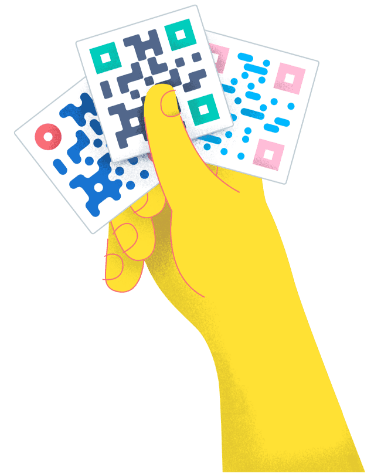- Best Practices ●
- COVID-19 ●
- Industry Trends ●
- Partners ●
- Product ●
QR Codes for Logistics: Simplifying Supply Chain Processes
Modern businesses can’t succeed without efficient logistics. Any business that makes or sells physical goods must have the means and processes to move them quickly and accurately—or they risk being outmaneuvered by a competitor who can.
Many professionals use QR Codes for business cards and other marketing materials. But QR Codes are more than just another way to get people to your website: They actually have a much richer history in logistics and supply chain (starting in Japan with a company called Denso Wave).
By giving businesses a way to store data-rich information that’s scannable, editable, error-correcting, and more, QR Codes can help streamline logistics processes and improve business outcomes.
Why QR Codes should be used instead of traditional barcodes in logistics
Most organizations with established logistics procedures that aren’t already using QR Codes rely on traditional barcodes instead. But QR Codes — a type of barcode, and often called “2D barcodes” — are the superior choice for all sorts of reasons.
Higher data capacity
This is a function of how QR Codes work: Because they can be read in two dimensions, not just one, they can store far more information than traditional barcodes. Where barcodes can usually store around 20 alphanumeric characters at maximum (most UPCs cap out at 10 or 12), QR Codes can store up to 3 KB of data.
That translates to 4,269 alphanumeric characters of storage in a QR Code, giving you plenty of space for more complex information.
Versatility
While traditional barcodes can represent only numeric or alphanumeric strings, QR Codes are far more versatile. They can store numeric and alphanumeric data (a lot more of it), plus they can store text strings and binary data.
This versatility enables them to be used for a wide range of applications, from tracking packages to providing rich product details.
Strengthened data security
Not only that, but QR Codes can also store encrypted data, making them a more secure option for sensitive information. This is particularly important when dealing with confidential logistics data or products that require strict tracking.
In other words, anyone with a barcode reader can extract the string of numbers and letters the barcode represents. But encrypted QR Codes can store encrypted data that’s only accessible to those who have the decryption key.
Benefits of using QR Codes in logistics
Integrating QR Codes into logistics operations unlocks a range of benefits for your organization, including these.
Improved inventory management
Managing inventory is easier with QR Codes. They can be created in bulk using a service like QR Code Generator PRO, and they can do more.
For example, where a conventional barcode can contain little more than a product identifier, a QR Code can contain a serial number, destination data, delivery window, and even a product description. A single scan reveals everything a team member (or robotic system) needs to know about an item.
QR Codes can also link up with inventory systems so that scanning updates data in relevant fields, keeping your inventory levels accurate and up to date.
Enhanced traceability
QR Codes also enable better traceability and inventory tracking because the QR Code can contain the tracking data inherently (rather than manually connecting a barcode scan to a database to find and then update tracking information). This results in better, more granular data on where inventory items are in the supply chain or fulfillment channel.
Real-time data access
QR Codes also enable real-time data access: Scanning a Dynamic QR Code gives up-to-the-second information to the reader (thanks to whatever databases the QR Code connects to). Scans also provide real-time updates in the opposite direction, such as updating a customer shipment tracking portal every time a QR Code is scanned, or making adjustments in the inventory management system.
Error reduction
Unlike traditional barcodes, QR Codes can be read even after some scuffing or destruction. This results in a lower rate of errors, leading to faster logistics processes and more satisfied customers.
How QR Codes can be used effectively in logistics
Making the decision to implement QR Codes in your logistics operations is the first step. But you’ll need to go further, deciding exactly where and how you’ll use them.
Here are six specific use cases where QR Codes can make an outsized impact on your business and its logistics.
1. Inventory management
First up is the one we’re most excited about for this post: inventory management itself. It’s what QR Codes were created to do, and they do a seriously good job here.
Because QR Codes can store multiple data fields, including the ones most relevant to inventory management, they can greatly enhance the way your human operators (and machinery) interact with inventory items. With a single scan, users can see all relevant data about an item, from what it is to where it’s going and when it needs to get there.
Want to go deeper into using QR Codes for this purpose? Read How to Use QR Codes for Inventory Management!
2. Order tracking
QR Codes can also enhance the way businesses handle order tracking. Since you’re already scanning that QR Code at multiple points in the customer fulfillment journey, it doesn’t take much to link those scans to an actual customer tracking portal.
Now, whenever that QR Code gets scanned during the fulfillment and delivery process, all interested parties (both end customers and your internal team members and vendors) can see the status and location of the order.
3. Asset management
Inventory isn’t the only kind of physical asset that needs managing. Businesses also need to manage physical assets that aren’t for sale, and QR Codes are just as strong in asset management as they are in inventory management.
By applying QR Code labels to warehouse assets (or any other types such as printers, laptops, and other hardware that tends to move around), organizations can keep better track of what’s where or on loan to whom.
4. Product traceability
QR Codes can be used for product traceability as well. Using QR Codes and the right inventory management software can show where a product has been over time, not just where it is right now.
This kind of traceability can identify bottlenecks or slowdowns in your supply chain or logistics processes, helping your organization commit to continuous improvement and keep getting better at meeting customer needs.
5. Document management
Document management is another area where QR Codes can be used. Digital versioning is a great innovation, but it doesn’t solve versioning issues in contexts where documents are printed and distributed.
By affixing a unique QR Code to each version of a document, you can create a document trail that solves versioning issues.
QR Codes can also help businesses quickly classify printed documents into various categories, saving valuable time that would’ve been spent analyzing each document for classification purposes.
6. Customer support and feedback
QR Codes can also be a stellar way to collect customer feedback and provide customer support. Businesses can slap a QR Code onto a product that can route customers directly to a tutorial video or customer support page, getting customers a quick response and increasing customer satisfaction.
Businesses can also leverage feedback QR Codes on the back of a manual or product packaging, for example, which sends customers directly to a survey or other feedback mechanism.
Steps to implement QR Codes in logistics
If your organization is just getting started with implementing QR Codes in logistics, follow these steps.
Assess your logistics needs
First, take time to assess your logistics needs. What problems are you trying to solve by implementing a QR Code system? Are you losing inventory? Is customer fulfillment taking too long? Is finding inventory in warehouses too much of a guessing game?
Your business faces similar challenges to others, but your needs are unique. So make sure you know what you’re solving for before doing the math. Only once you have a clear understanding of your logistics needs are you ready to start implementing solutions.
Choose the right QR Code generator
QR Codes are easy to use and easy to generate. But doing so at scale, using data coming from multiple sources, requires the right tool for generating those QR Codes.
Some QR Code generators are great for personal use but lack the feature set to scale with you, or even to support basic business needs.
QR Code Generator is the ideal solution for businesses to create QR Codes for logistics. With a powerful backend editor, you can create next-gen QR Codes with a high level of customization. There’s also built-in bulk QR Code creation using our CSV templates or our API.
Labeling and placement
QR Codes will typically be printed onto labels for your inventory and shipping use cases. The placement of these labels is important: whether you’re relying on hand-picking or machine automation order fulfillment (or a mix of both), the humans and machines doing the work need to be able to consistently and quickly scan every QR Code.
Make sure placement is consistent, visually obvious, and in the proper alignment for any automated scanners.
Data integration
Remember, QR Codes can do more than just show you basic information. You can embed lots of rich data into them, and the possibilities for how you use them and how you integrate the data within them are nearly endless.
QR Codes can be a big part of the solutions to your data challenges, but first, you need to define those challenges.
For this step, go back to the first step (assessing your needs) and ask that question again, but from a data angle: what data do you need to be collecting? What do you need that data to do for you?
Employee training
Whatever your current logistics procedures look like, they will change at least a little bit when you migrate over to QR Codes. Conduct a thorough workflow analysis to understand what your employees are currently doing, and what will change once you make the switch.
Involve employees and leaders in this process by soliciting their input on where processes will need to change due to the switch. You’ll likely want to do a few test runs as well, making sure that your plans survive the real world without creating new complications.
Monitoring and maintenance
The last step in implementing QR Codes in logistics is monitoring the process. No process is ever 100% foolproof on the first attempt. Monitoring is essential so that the implementation process can be adjusted when needed and the entire logistics and inventory system can be properly maintained.
Streamline your logistics processes with QR Code Generator
Logistics processes work better with QR Codes. But implementing QR Code solutions at scale requires the right solution for creating and managing those codes.
QR Code Generator PRO is the best QR Code generator for logistics companies and any business handling its own logistics. With a powerful dashboard, businesses can configure QR Codes from a central hub (even adjusting where those QR Codes point after the fact).
And thanks to a powerful bulk QR Code creation tool and a robust API, organizations can adapt QR Code Generator PRO to fit the unique needs of their business.
Start streamlining your logistics processes with better QR Codes using QR Code Generator. Get started for free now!





